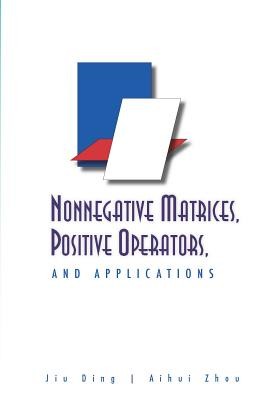
- We will send in 10–14 business days.
- Author: Aihui Zhou
- Publisher: World Scientific Publishing Company
- Year: 2009
- Pages: 345
- ISBN-10: 9812839178
- ISBN-13: 9789812839176
- Format: 15.5 x 22.9 x 2.5 cm, kieti viršeliai
- Language: English
- SAVE -10% with code: EXTRA
Nonnegative Matrices, Positive Operators, and Applications (e-book) (used book) | bookbook.eu
Reviews
Description
Nonnegative matrices and positive operators are widely applied in science, engineering, and technology. This book provides the basic theory and several typical modern science and engineering applications of nonnegative matrices and positive operators, including the fundamental theory, methods, numerical analysis, and applications in the Google search engine, computational molecular dynamics, and wireless communications.Unique features of this book include the combination of the theories of nonnegative matrices and positive operators as well as the emphasis on applications of nonnegative matrices in the numerical analysis of positive operators, such as Markov operators and Frobenius-Perron operators both of which play key roles in the statistical and stochastic studies of dynamical systems.It can be used as a textbook for an upper level undergraduate or beginning graduate course in advanced matrix theory and/or positive operators as well as for an advanced topics course in operator theory or ergodic theory. In addition, it serves as a good reference for researchers in mathematical sciences, physical sciences, and engineering.
EXTRA 10 % discount with code: EXTRA
The promotion ends in 23d.13:28:15
The discount code is valid when purchasing from 10 €. Discounts do not stack.
- Author: Aihui Zhou
- Publisher: World Scientific Publishing Company
- Year: 2009
- Pages: 345
- ISBN-10: 9812839178
- ISBN-13: 9789812839176
- Format: 15.5 x 22.9 x 2.5 cm, kieti viršeliai
- Language: English English
Nonnegative matrices and positive operators are widely applied in science, engineering, and technology. This book provides the basic theory and several typical modern science and engineering applications of nonnegative matrices and positive operators, including the fundamental theory, methods, numerical analysis, and applications in the Google search engine, computational molecular dynamics, and wireless communications.Unique features of this book include the combination of the theories of nonnegative matrices and positive operators as well as the emphasis on applications of nonnegative matrices in the numerical analysis of positive operators, such as Markov operators and Frobenius-Perron operators both of which play key roles in the statistical and stochastic studies of dynamical systems.It can be used as a textbook for an upper level undergraduate or beginning graduate course in advanced matrix theory and/or positive operators as well as for an advanced topics course in operator theory or ergodic theory. In addition, it serves as a good reference for researchers in mathematical sciences, physical sciences, and engineering.


Reviews